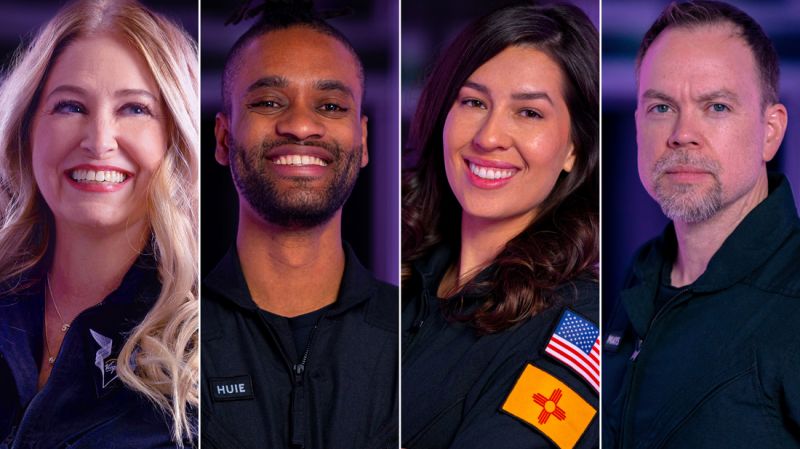Sign up for CNN’s Wonder Theory science newsletter. Explore the universe with news on fascinating discoveries, scientific advancements and more.
Virgin Galactic, the suborbital space tourism company founded by British billionaire Richard Branson, is gearing up for its first flight to the edge of space in nearly two years.
The flight, slated for late May, will carry two pilots and a crew of four Virgin Galactic employees, the company announced Monday. The company expects it will be the final test run before Virgin Galactic can open up rides for paying customers after years of promises, missed deadlines, and Branson selling off a huge chunk of his original stake in the company.
If all goes well, Virgin Galactic expects to begin commercial services out of its spaceport in New Mexico in late June.
Virgin Galactic had appeared poised to begin commercial operations after it launched Branson to the edge of space alongside three crewmates in July 2021, a flight that came less than two weeks before Branson’s rival Jeff Bezos conducted his own flight to the edge of space. Branson denied he had been racing with Bezos.
But the Federal Aviation Administration, which licenses commercial rocket launches, later opened an investigation into Branson’s flight when it was revealed that the space plane veered off course during the high-profile flight.
That investigation concluded in September 2021 and gave Virgin Galactic the all-clear for more flights. But the company then announced it was delaying the start of commercial services, citing unrelated technology upgrades.
Several deadlines for the company’s expected return to space have passed. At one point in early 2022, the company was targeting as early as last October for its first commercial missions. At the time Virgin Galactic went public in 2019, it had also been touting plans to start commercial service in 2020.
“We are making good progress on validating the enhancements made throughout 2022, and we remain on track for commercial service in Q2 of this year,” CEO Michael Colglazier told investors during the company’s latest earnings call on February 28, 2023.
Virgin Galactic conducted several test flights before Branson’s flight in 2021. But since then, the company has flown only one test flight of VSS Unity, which sent the space plane gliding through the air but did not attempt to fire up the plane’s rocket engine.
The company has also been losing money for years, burning through funds as it attempts to finish its qualification flights and begin welcoming customers on board — some of whom paid for their tickets more than a decade ago.
The company has sold about 800 tickets total, including 600 at prices ranging from $200,000 to $250,000 and 200 more at $450,000, which is the current ticket price, a spokesperson confirmed on Monday.
Virgin Galactic is competing directly with Bezos’ Blue Origin in the suborbital space tourism business. Since Bezos’ flight in July 2021, the company has since completed five additional crewed flights to space. Blue Origin’s operations, however, have been on pause since an uncrewed flight of its New Shepard rocket exploded in September 2022.
Six people will be on board Virgin Galactic’s VSS Unity space plane for this month’s test mission. They include two pilots — CJ Sturckow and Mike Masucci — as well as four Virgin Galactic employees who will ride in the passenger cabin. Those four are Jamila Gilbert, a New Mexican native who works in the company’s internal communications; Chris Hume, a flight sciences engineer and the son of Jamaican immigrants; Luke Mays, an astronaut instructor and former NASA employee; and Beth Moses, the company’s head of astronaut training, who has joined two prior flights.
Virgin Galactic’s rocket-powered plane, called VSS Unity, is designed to ride to about 50,000 feet while attached beneath the wing of a massive, twin-fuselage mothership, dubbed “Eve” by the company. The space plane is designed to then detach from the mothership, fire its rocket engine and swoop straight up with its two pilots at the controls. Flights are designed to reach more than 50 miles above Earth, into altitudes the US government recognizes as the boundary of outer space.
Not every institution recognizes the 50-mile mark. Internationally, it’s more common to use the Kármán Line, which lies 62 miles (100 kilometers) above Earth’s surface.
At the peak of the flight, customers are expected to experience a few minutes of weightlessness and can peer out the plane’s windows at Earth’s curved horizon and the blackness of outer space. VSS Unity then aims to glide to a landing back at the launch site. From takeoff to landing, the missions typically last under two hours.
Virgin Orbit, a sister company to Virgin Galactic that is focused on launching satellites to space on a small rocket, filed for bankruptcy in April.
Read the full article here
